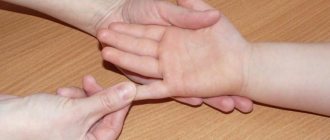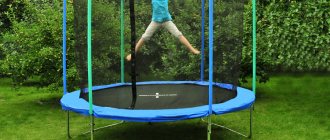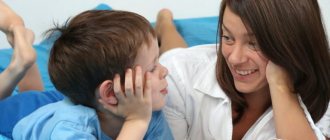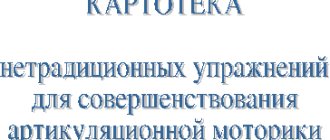Some children try to speak, but those around them do not understand their speech. Problems with expressing thoughts can become an obstacle to communication with peers and even lead to a decrease in self-esteem. They can be solved with the help of a special speech therapy massage.
The procedure must be performed by a specialist. But parents can also learn simple techniques.
What is logomassage and why is it needed?
Speech therapy massage is a method of physiotherapy aimed at developing a child’s speech. Exercises also help improve articulation and correct phonological and voice disorders. Just a few sessions with a speech therapist will help your child express his thoughts more clearly and clearly.
Massage for a child’s speech development is indicated for the following problems.
1. Poor articulation, poor formation of words and sentences.
Children with speech problems cannot clearly pronounce complex words and unconsciously speak in whole sentences. Logomassage develops the skills of fluently linking sounds into separate words.
2. Adjusting speech volume.
Young children sometimes speak too quietly or loudly, not because they are embarrassed (they want to attract attention), but because they do not know how to control the muscles of the larynx and how to properly direct their breathing. Massage will help you consciously control these parameters.
3. Inability to correlate sounds with graphic images.
Speech impairments that are not corrected early in life can lead to problems with written language. A speech therapist will help you not only pronounce letters correctly, but also describe them graphically.
Typically, children begin to speak clearly by age five. Before this age, the child may have “breakthroughs,” when the baby begins to make conscious sentences, and periods of silence.
Can massage be speech therapy?
Everyone is familiar with the concept of massage in general, the usefulness of which for many conditions is beyond doubt. Under the influence of the work of a massage therapist, blood circulation in tissues improves, their nutrition improves, and the movement of lymph accelerates. The impact on the muscles improves their elasticity and ability to contract and relax.
Based on the need, various movements are used to either increase muscle tone or relax and get rid of spasticity.
Children are often prescribed speech therapy massage for dysarthria, voice disorders, mental retardation and mental retardation, correction of speech disorders accompanying cerebral palsy and other neurological diseases.
As a result of improved blood and lymph movement, there is also a more active blood supply to the blood vessels of the brain, which affects its functioning and the processes of restoration of the central nervous system.
With the help of speech therapy massage it is possible to achieve:
- Improving the functioning of the muscles that make up the speech apparatus.
- Reducing the increased tone of the muscles involved in the reproduction of sounds.
- Better control of the child over the movements of the tongue and facial muscles.
- Increases the sensitivity of the entire speech apparatus.
- Reduce salivation.
- Creating conditions for the functioning of the speech organs, which prepare the child for clear and correct pronunciation of sounds.
Speech therapy massage can be:
- Classic. As the name implies, it uses conventional massage techniques, but in this case the facial muscles, cervical-collar area, and tongue are massaged.
- Pointed. In this case, the active points of the body are affected, relaxing or stimulating them.
- Zondov. It is distinguished by the use of a set of probes designed specifically for speech therapy purposes. With the help of these probes, the necessary areas of the articulatory apparatus are affected. It has been proven to be highly effective when working to improve sound pronunciation.
- Hardware. The process is based on the use of devices.
According to its purpose, speech therapy massage is divided into:
- activating the work of articulatory muscles
- relaxing.
How to know when it's time to seek help
You should not hire a speech therapist for a one-year-old child who is not yet physically formed to pronounce sounds correctly. But you shouldn’t delay asking for help. By first grade, your child should already be able to communicate freely.
If you have doubts about the advisability of logomassage, you should focus on the following criteria.
You need to seek help if your child is over 5 years old, but his speech is unclear and it is difficult for others to understand the essence of the appeal.
When reading or trying to retell long stories, the baby stutters, repeats the same words, and lengthens sounds.
We should be wary of trends towards simplifying phrases. For example, instead of saying: “Mom, I want to wear green pants, not red,” the child begins to become hysterical, shouting: “Mom, I don’t want to.” The help of a speech therapist is definitely needed if speech problems prevent the child from establishing first social connections with peers.
The child may have the ability to read aloud and demonstrate excellent pronunciation in the family circle. But if the child withdraws in public, then it is worth “rehearsing” the process of communication with a specialist.
A clear indication for seeking professional help will be diagnosed diseases, including:
- Down syndrome;
- autism;
- hearing loss.
In such cases, you should not wait for a certain age. Tongue massage is necessary for a child to develop speech. Additionally, you can consult with a speech pathology specialist. Your doctor will help you develop a home exercise program.
Many complex conditions require the participation of other specialists, for example, a psychologist works with children with cerebral palsy.
Contraindications
Speech therapy massage can only be performed if the child is in good general condition. It is contraindicated for:
- viral diseases that are accompanied by fever, cough, runny nose;
- stomatitis, gingivitis, sore throat and other diseases of the oral cavity;
- skin diseases - herpes, chicken pox, allergic rash;
- any diseases and conditions in which the baby’s well-being is impaired - teething or loss of baby teeth, fatigue;
- episyndrome;
- severe mental disorders.
In these conditions, it is better to wait with massage or abandon it completely. If a child suffers from colds or has an inflammatory process in his mucous membranes, you need to consult a doctor so that you can be prescribed treatment. Speech correction can begin after the condition has normalized.
Logomassage technique
The procedure is aimed at working the muscles located inside the mouth, including the lips, tongue, cheeks and even the throat. Speech disorders may be associated with underdeveloped or, conversely, overly toned muscles and uncoordinated movements of the tongue.
Surprisingly, the skills required to speak correctly are also useful for eating and drinking safely.
Logomassage can use both passive movements, when the specialist himself presses on the necessary muscles and ligaments, and active ones: the child himself performs the necessary movements. But in most cases, the doctor and his little client work together.
1. Lip work.
The child should alternately and drawlingly say the letters “o”, “u”, “e”, “i”. The massage therapist can help shape the lips into the appropriate shape.
It is better to use your index finger and thumb. You can also gently help your baby relax his cheeks. Parents without experience who plan to conduct logomassage at home are advised to first pronounce the sounds themselves and understand in which part of the cheeks strong tension appears. It is this area that the child needs to gently massage.
Between “singing” sounds, the baby can puff out his cheeks and lips. This will also help you relax and prepare for new exercises.
2. Tongue massage.
A muscle that is too weak or too tight interferes with articulation. Special tools can be used for massaging: hammers, scrapers, rollers. But at home it is better to do without additional accessories. To work on the language, you need to pronounce the so-called “front-lingual” sounds “tttt”, “dddd” with the child.
In this case, the baby should try not to touch the inner surface of the lips with his tongue. The tip should rest against the teeth.
3. Strengthening the cheek muscles.
In order for your baby to correctly pronounce hissing and whistling sounds, it is necessary to eliminate tension in the cheeks. To do this, knead the child's face along the jaw bone. You can gently press four fingers on the skin, moving from the nasolabial fold to the ears.
Active massage should still be left to a certified specialist who knows exactly which points to press on.
Massaging can tire the baby, so it is better to carry out the procedures at home in the form of a game.
For example, you can invite your child to blow soap bubbles.
Children love this kind of entertainment! But blowing bubbles teaches you to control your breathing. Also, the baby will have to constantly curl his lips into a tube, which is also one of the elements of logomassage.
If the sound effects aren't scary, buy a harmonica.
Playing a musical instrument “teaches” a child to control breathing, compress and unclench his lips. If you have problems with weak breathing, then the harmonica will help solve the problem and also increase the strength of your lips.
Those with a sweet tooth will love the “lick yourself” exercise.
You need to rub a little jam or condensed milk into the corners of your lips and ask your baby to lick himself thoroughly. The tip of the tongue should “walk” from side to side.
The exercises listed above are quite easy, but it is better to do them in a playful way. Children quickly get bored with monotonous movements, so it is better to sing songs, make faces and take funny photos at the same time as the logomassage. Game exercises can be repeated three to six times every day.
But remember that every child is unique and learns at their own pace, so progress may take a few days or a few months.
How is speech therapy massage performed?
This method of speech therapy work is quite effective, but should be performed exclusively by a specialist with certain skills and education. For parents, we offer information on how speech therapy massage should be carried out:
- The appointment should occur only after the examination has been completed.
- Massage is carried out in courses - 10 or 20 sessions. The milder the speech disorder, the shorter the duration of the course and the sessions themselves may be.
- As a rule, sessions are scheduled 2 times a week or more often and are included in speech therapy classes.
- Depending on the type of massage, the child will be asked to either sit in a chair or lie down on a massage table. Often children are not ready to lie down immediately for a massage. A good specialist will not put pressure on the child, but will give him the opportunity to get used to it gradually.
- Manipulations should not be painful.
- The duration of the session again depends on the type of speech disorder and the child’s condition. However, the first session, as a rule, lasts only a few minutes and during this time only general relaxing strokes are used. This is done so that the child gets used to the procedure and does not feel fear.
- If the child is worried, at first the speech therapist may suggest that he sit on a chair or on his parents' lap during the procedure.
Parents must understand that speech therapy massage is not a panacea. If your child undergoes this procedure, you should not relax and assume that the problem is solved. Massage is only a piece of the overall puzzle that makes up correctional work. To achieve results, it must be combined with special speech therapy classes and home assignments.
Date of publication: 08/13/2016. Last modified: 01/29/2021.
Alternatives to logomassage
Speech therapist services are not that expensive. But parents whose child does not show positive results begin to look for alternatives to the procedure.
One option is neurofeedback or bioacoustic correction.
During the procedure, sensors are attached to a person's scalp to record brain wave activity. The doctor will be able to record the graph of brain activity during communication. The child is then fitted with headphones through which the “voiced” brain signals can be heard. This treatment is prescribed to children with severe speech delays.
Music therapy is more suitable for young patients without mental retardation. The baby is encouraged to listen to rhythmic songs and sing along to them.
Facial massage for speech development
During this speech therapy massage, a specialist uses his hands to work on the child’s forehead, cheeks, nose, mouth and chin. The massage complex includes stroking, rubbing, kneading and vibration of these facial areas.
Forehead massage
The massage is carried out in the following way:
- with stroking movements of the palms move from the middle of the forehead to the temporal part;
- Using kneading movements, the hands massage the forehead from the eyebrows to the top of the forehead;
- Vibrating movements of the hand or a vibrating massager move from the eyebrows to the upper part of the forehead.
Tongue massage
Cheek massage
Next, massage the cheeks:
- kneading and rubbing movements are directed along the muscles of the cheeks - from the corners of the mouth to the temples;
- Lightly stroking the cheeks move from the cheekbones to the bottom of the jaw.
Mouth massage
This area is massaged like this:
- stroke, stretch and rub the skin of the upper lip from the middle to the corners of the mouth;
- The lower lip is massaged with similar movements.
Chin massage
The chin is stroked and kneaded, starting from the bottom and moving to the corners of the mouth.
Where to find a logomassage specialist
Speech therapists deal with speech problems. Even if parents want to independently conduct logomassage for children at home, it is necessary to attend at least a preliminary consultation. The doctor will help determine the type of problems and schedule exercises to perform.
On the website 7hands.com you can find certified speech therapists who will conduct an appointment in their office or at the client’s home. To achieve optimal results, it is worth ordering at least one full course of logomassage. Parents will be able to attend the procedure and learn the influence techniques.
Professional logomassage will help solve several problems at once:
- improve understanding of other people's speech;
- express your own thoughts more clearly and clearly;
- use speech in socially acceptable ways (do not express your wishes by shouting, do not shout out individual sounds instead of spending time building full-fledged phrases).
A logomassage course can last from several weeks to several months. It is important not to skip procedures and do all your homework. And a positive result will not be long in coming.
Contraindications – when is tongue massage harmful to a child?
The absence of contraindications is determined by a neurologist - the doctor documents the safety of the massage for the child (manipulations at home, in a government institution, or with a private specialist are prohibited without a certificate). You cannot massage your tongue if:
- there are injuries, wounds, cuts in the oral cavity;
- diagnosed with stomatitis, gingivitis, common infectious diseases;
- the child has enlarged lymph nodes;
- the child is afraid of the procedure - often the fear is caused by the unknown and the frightening appearance of the instruments;
- there are blood supply disorders, fungal infections, cancer;
- hypersensitive skin.
Doing a tongue massage on a child with your own hands is not easy; it is better to entrust this task to a professional massage therapist - ideally a child massage therapist, since such a specialist knows how to work with children, easily finds an approach to them, and carries out procedures without hysterics or discomfort for children. Moreover, without the proper experience and skills, a parent can injure the child, cause him pain and fail to achieve the goal - the manipulations will be useless, and invaluable time will be lost.
Causes and symptoms of motor alalia
Motor alalia is caused by damage to the so-called Broca's frontoparietal center, one of the areas of the brain. The task of this center is to develop skills in voicing speech, or, more simply, the ability to generate sounds so that they are understandable to others. With motor alalia, the child perceives other people’s speech well, understanding what his parents and other people are telling him. However, when trying to speak on their own, such children experience problems.
The first symptoms of motor alalia become noticeable a few months after the birth of the child. He cannot babble, and his babbling is limited to monophonic sounds. He begins to form the first syllables after a year of life, and the first words appear only after three years, when other children speak quite tolerably. The voice of such children is loud and sonorous; The child pronounces individual sounds quite clearly, but he is unable to put them into words. The vocabulary of a five-year-old child with motor alalia is very limited, although healthy children by this time know about one and a half thousand words.
The problems are also related to the fact that it is difficult for a child to recognize words if they differ slightly from each other in sound, but have completely different meanings. As soon as a child forms for himself one visual image and the semantic meaning of a word, a concept similar in pronunciation to it can drive him into a stupor. If parents begin to push the child, demanding correct answers from him, this further aggravates the situation. In such cases, experts advise not to panic and under no circumstances forcefully retrain children. At the same time, this violation cannot be ignored. Perhaps it will pass over time, but if before entering school the child still pronounces words incorrectly, he needs to be shown to a doctor - a neurologist and speech therapist. The first specialist will identify abnormalities in the functioning of the nervous system, and the second will deal with the actual production of speech.
A mild form of motor alalia, in general, does not pose obstacles to the child’s communication with adults. Such children usually use words in the nominative case and put endings incorrectly, but this allows others to understand them. However, if a child does not recover from alalia, he may have serious problems at school, especially in Russian language lessons. But severe motor alalia causes a lot of problems even in early preschool age. Such children can only imitate certain sounds, and when communicating they actively help themselves with facial expressions or gestures.
If we talk about the behavior of children with motor alalia, it can be completely opposite. Children can be both mentally inhibited and hyperactive. The speech of these children is loud and sonorous, although the sounds are pronounced incorrectly or not in the right order. It is difficult for them to focus attention during classes, they get tired quickly and do not have a good memory, and have difficulty performing even the simplest logical actions. Another sign of motor alalia is the inability of children to perform fine work with their hands and fingers, since fine motor skills are closely related to the speech centers of the brain.
Pre-warm-up
You need to start the session with a general facial massage for a few minutes. You need to perform pleasant stroking and vibrating manipulations for the baby. Directions may be different:
- The forehead is massaged from bottom to top and from the center to the temples.
- The lower eyelid needs to be worked from the outer edge to the inner, the upper - vice versa.
- Movements are performed from the nose to the temples and from the edges of the lips to the ears.
- Manipulations are also done from the chin to the earlobes.
To relax the muscles of the neck and root of the tongue, the baby's head sways and smoothly turns to the sides. Then the work on the tongue and lips begins.
Types of alalia
There are three types of alalia in total. Sensory alalia is characterized by a speech perception disorder when the child cannot understand what is being said to him. Motor alalia is a disorder in which the child has difficulty pronouncing some sounds or does not speak at all, although he understands well what others are saying to him. Finally, the third type of disease - sensory-motor - combines both problems of speech development.
A newly born baby's speech centers are not developed, so he cannot speak. But if he is completely healthy, then gradually he will go through all the stages of development and begin to speak as well as his parents. If certain areas of the brain are affected, one or another form of alalia appears. Speech centers are located in the temporal and frontal lobes of the brain. Speech itself is divided into impressive (that is, the ability to listen to an interlocutor, understand his meaning, form visual images and expand vocabulary) and expressive (the ability to speak). If a child has alalia, he does not speak at all, or speaks some incomprehensible language in which neither individual words nor the meaning of spoken sentences can be guessed.
Physiotherapy
Physiotherapeutic methods are aimed at strengthening the body and stimulating the nervous system. These include water treatment (mechanical, temperature or other effects on the body), ultrasound treatment, magnetic field, weak electrical impulses, etc. In any case, regardless of the methods used, the correction must be comprehensive and systematic. Only a neurologist can prescribe these procedures. Since speech is an important and frequently used skill, parents should perform speech therapy exercises at home on their own as directed by a specialist.











